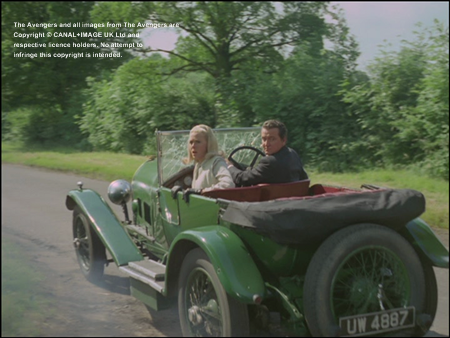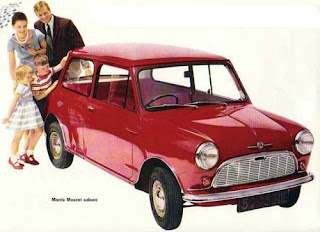The 1966 and 1967 Corgi catalogues included illustrations of 9022, a 1910 Daimler 38 with a hood, marked as AVAILABLE LATER. To all intents and purposes this looked like 9021, a red Daimler 38 with folded back hood and driver plus a full load of passengers, but painted blue with a red-brown closed hood.
Corgi were good at making one casting do several things. This one, however, never got into production. What I have here is a sample, looking almost complete but lacking a steering wheel.
A full selection of images of this unique item can be seen here.
It is in excellent condition with no chips or scratches, the screen has survived and so too has the vulnerable radiator emblem.
I also have the 9021 Daimler which may also have been a sample but it appears indistinguishable from examples of issued models that I have. I would, nevertheless, prefer to see these kept together in case, at some point, someone does spot some differences. Shown above is a production model and, below, the model in the Wilford Collection.
What is quite different, however, is one of the 1927 Bentley 3 Litres in the collection. This clearly was intended to be an example of a model with the hood down by the look of the windscreen(s) which would not have supported the full length hood. The horn on the side is painted bright silver, as opposed to the black on issued models, and there is a very detailed dashboard with a tremendously realistic-looking (albeit rather small) steering wheel. This needs a rear folded hood, in my view, but they are simple enough to obtain and I may well supply one with this when sold.
You can see where the idea for this style of screen came from.
Whether this was an early sample for what would become 9001 I do not know. It may also have been the older Mr Wilford's team working with an existing 9001/2 body to create a different edition, perhaps even an idea for Steed's Bentley in the Avengers Gift Set. It would have been in keeping with the Bentley they might have seen in the instalment this screenshot came from:
However, here's John Steed again in a Bentley with the same registration - but it's on a 3 litre car now not the 4½ litre!
I have visions of some confusion in the office as the series progressed! Do they re-brand the model 4½ litre? Do they move the spare wheel, not just from left to right but maybe to the rear? That might explain the odd editions that they did include, none of which bear more than passing resemblance to any of the Steed vehicles.
Another Bentley was in the Wilford office drawer. It looks like a standard 9001 at first glance.
The wheels, radiator and headlamp unit and handbrake are all in a gold-coloured metal rather than the usual grey or silver colour. We know that this gold colour appears on the 9004 Jeeves & Wooster Bentley and, reportedly, in some Avengers Sets but this one has a RN3 on the back and the Union flag on the passenger door à la 9001.
The screen has a chunk missing and this also needs a hood of some type but is otherwise complete and in very good condition. It is certainly another unusual edition and will be made available soon, possibly paired with the small twin screen edition and a complete 9002 from the same source that does seem totally standard.
 |
| From The Great Book of Corgi. "Some very near Misses". |
 |
| From the 1966 Catalogue |
 |
| Still shown in the 1967 Catalogue |
I do believe that the 9022 Daimler is unique in being the only proposed model that remained AVAILABLE LATER across two catalogue printings.
These items are available to purchase. Contact me if you would like more information.









.png)





















